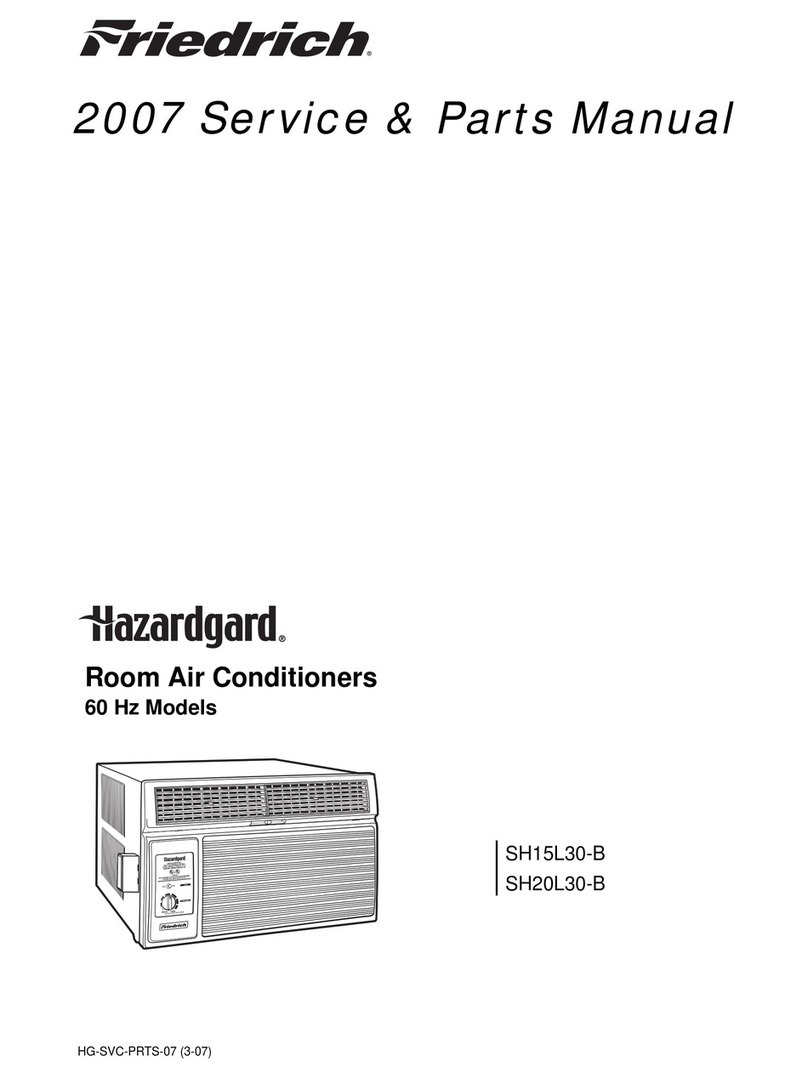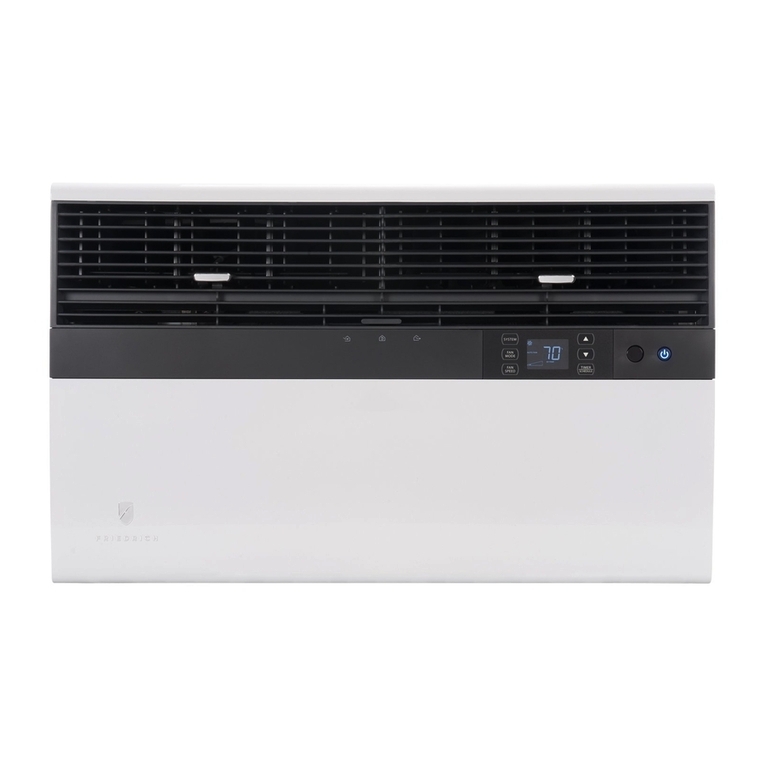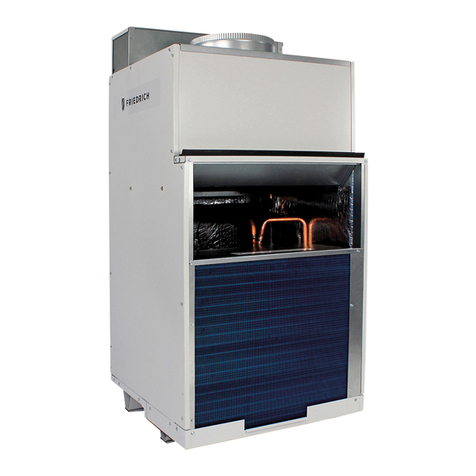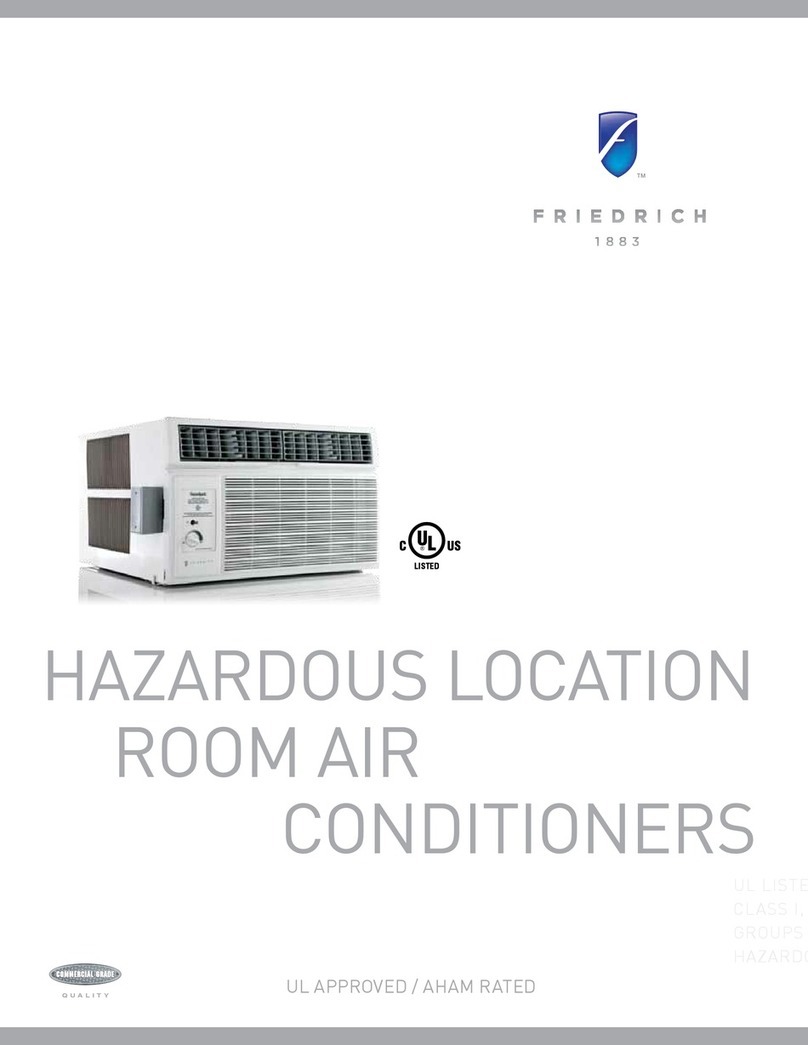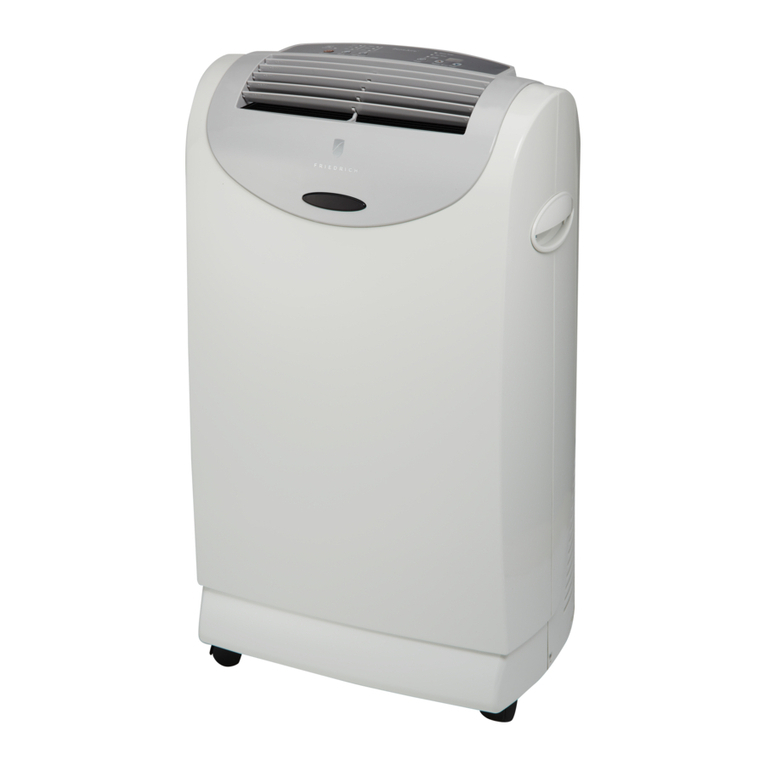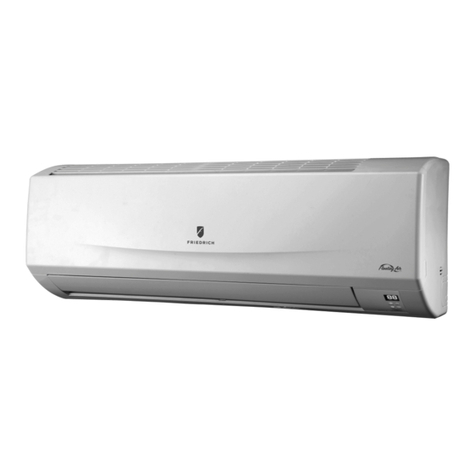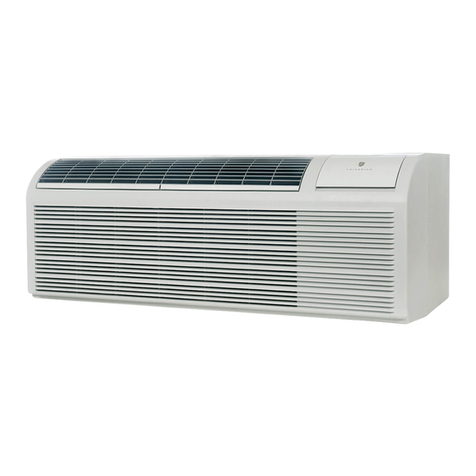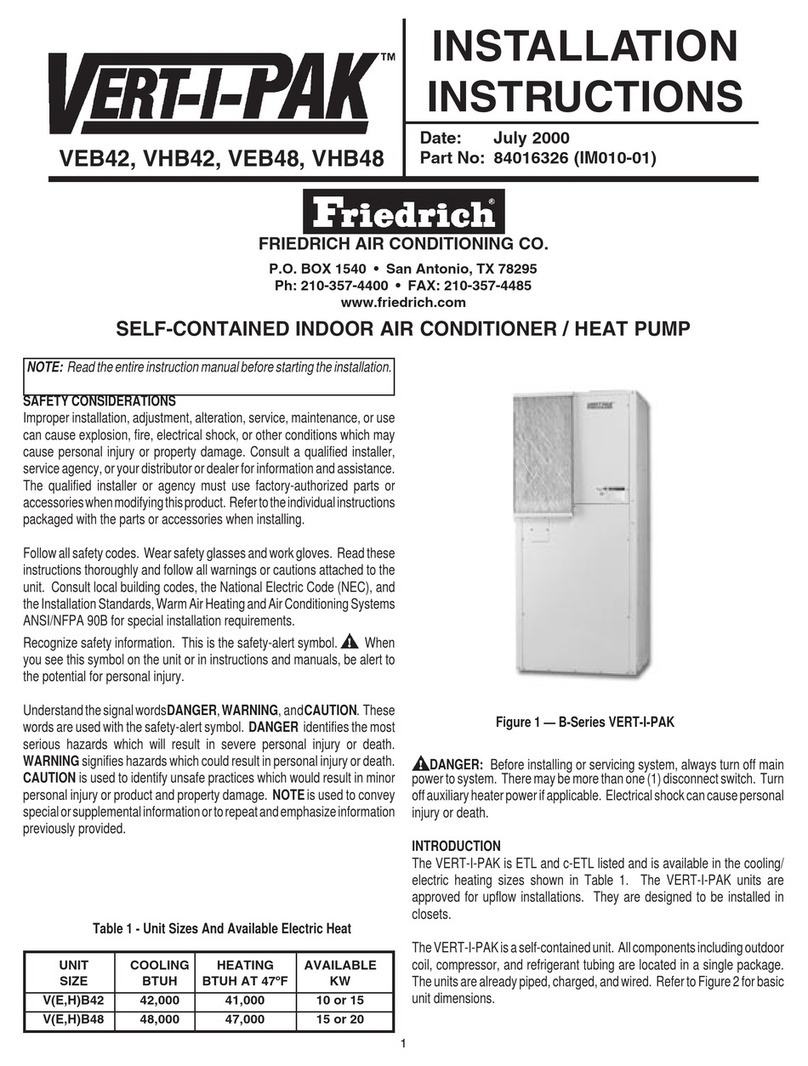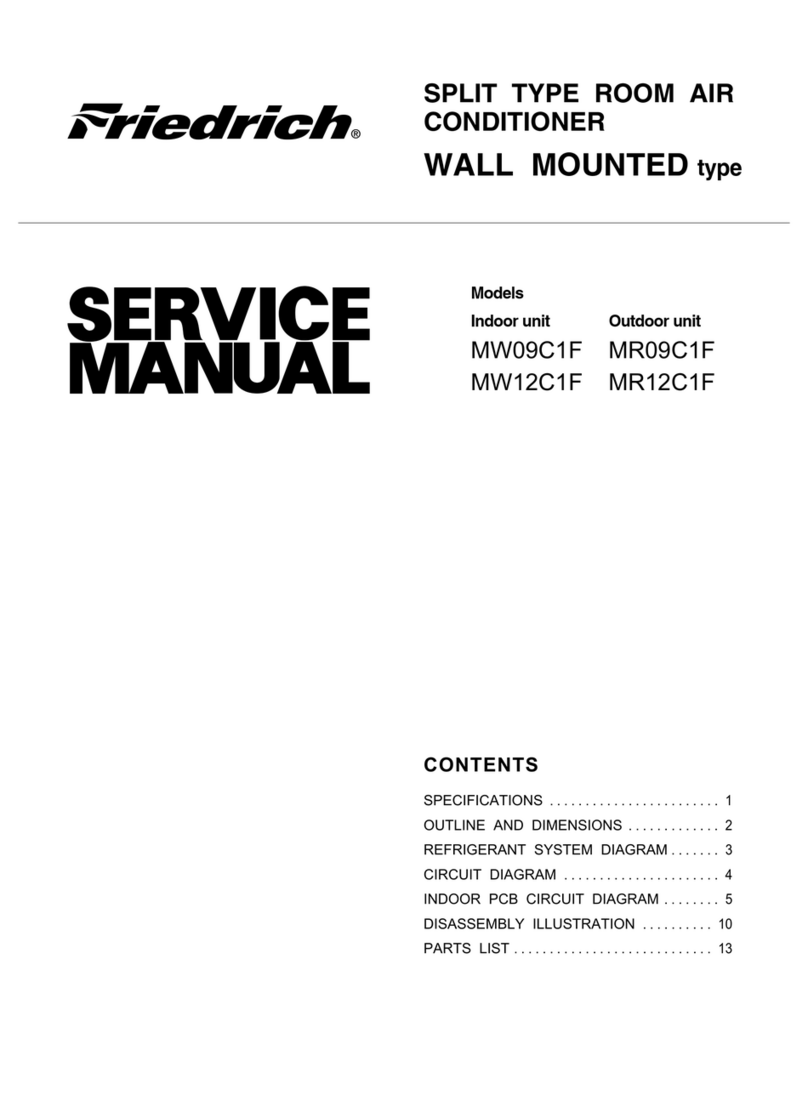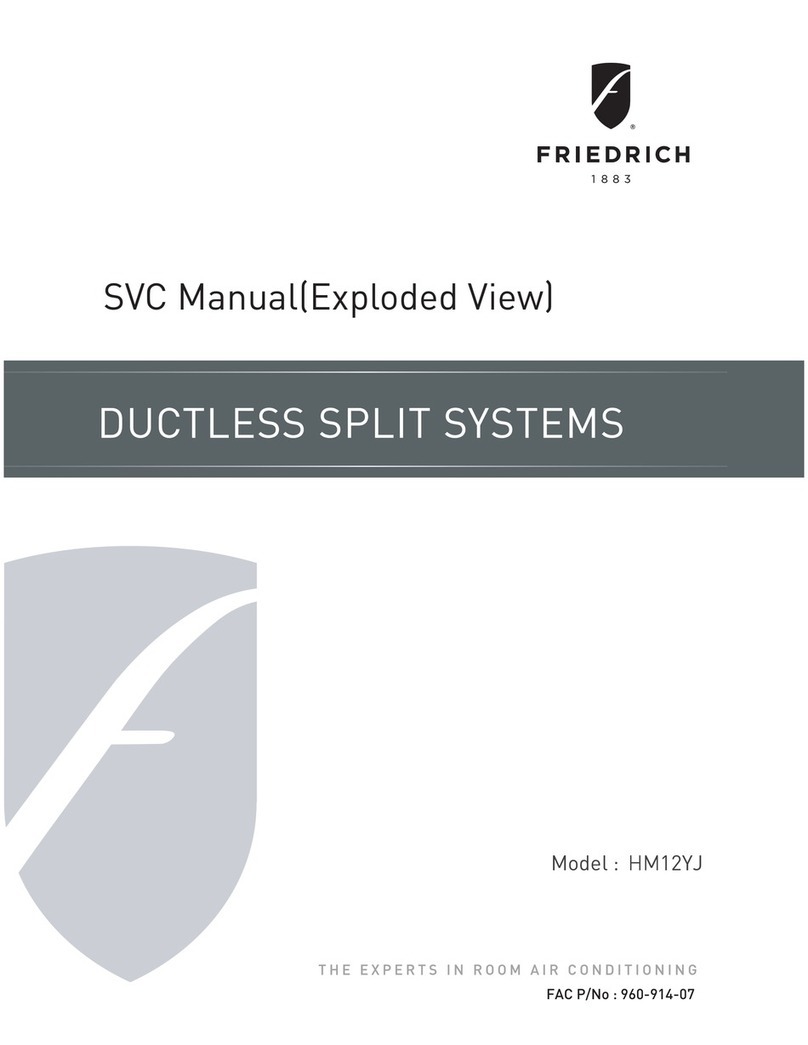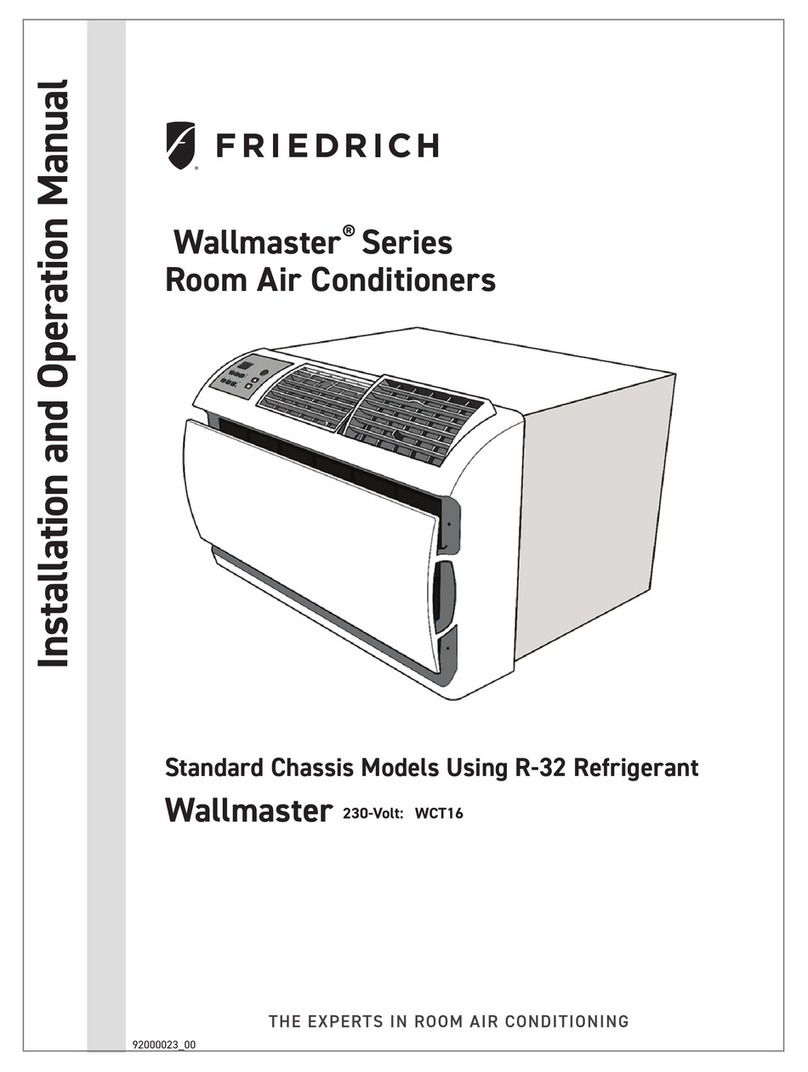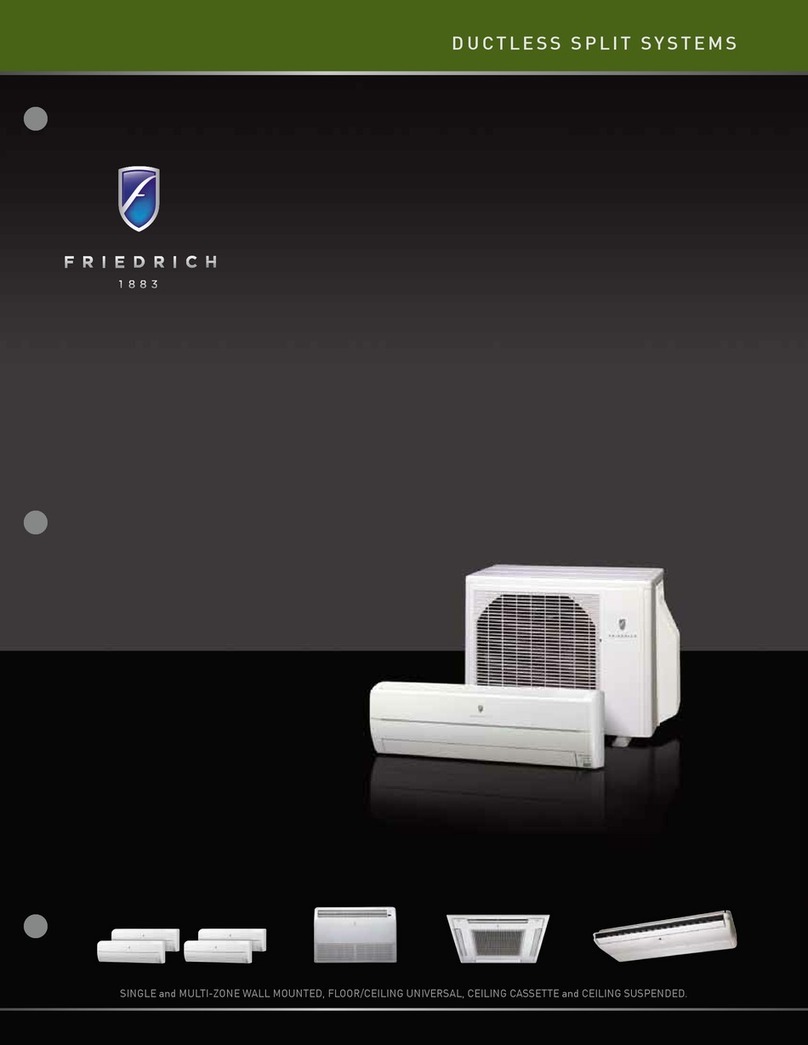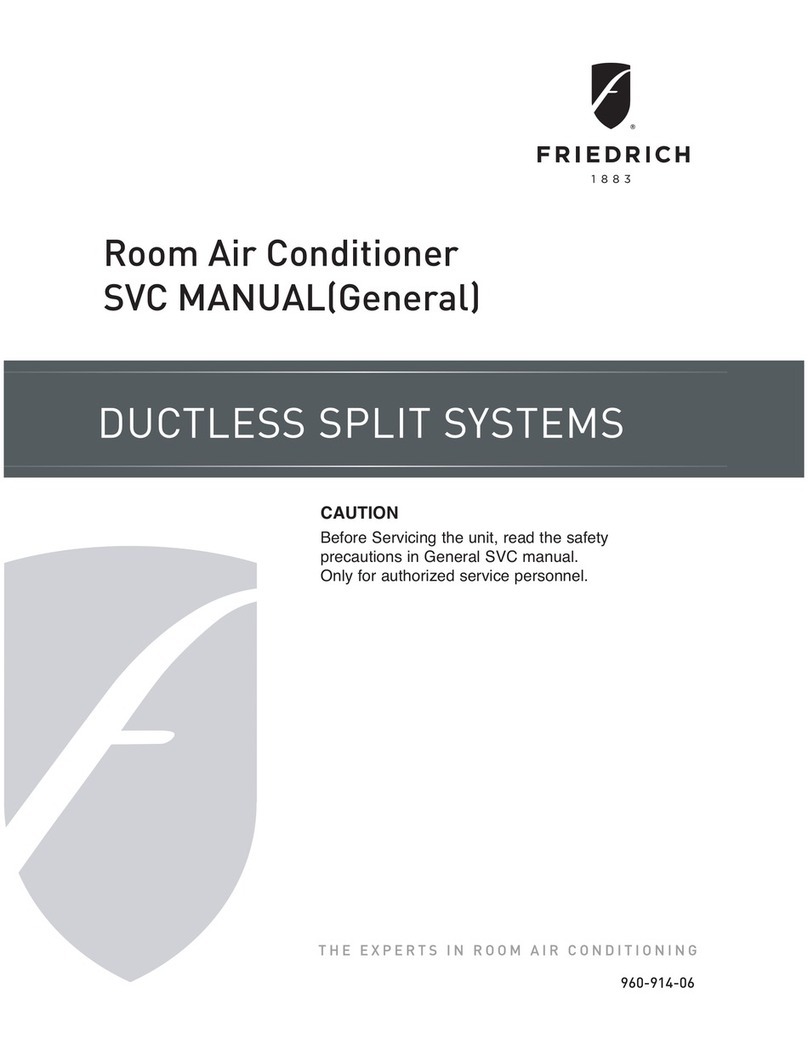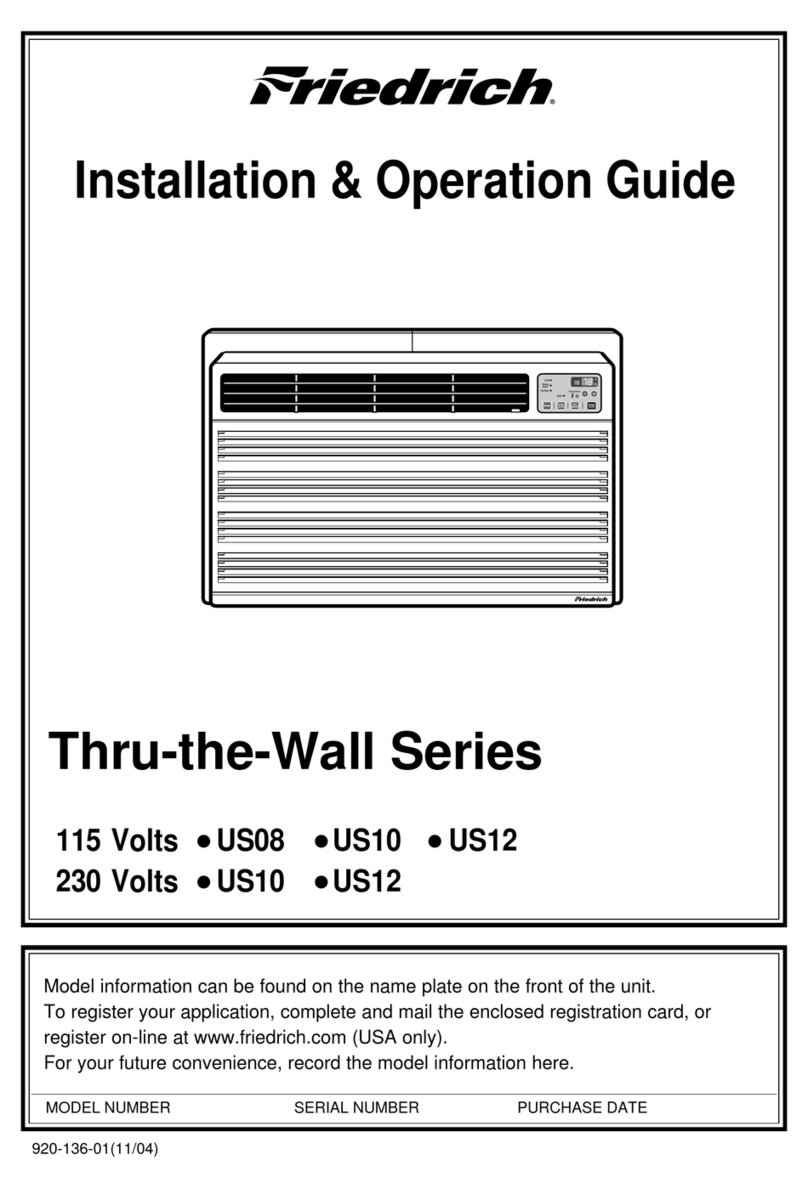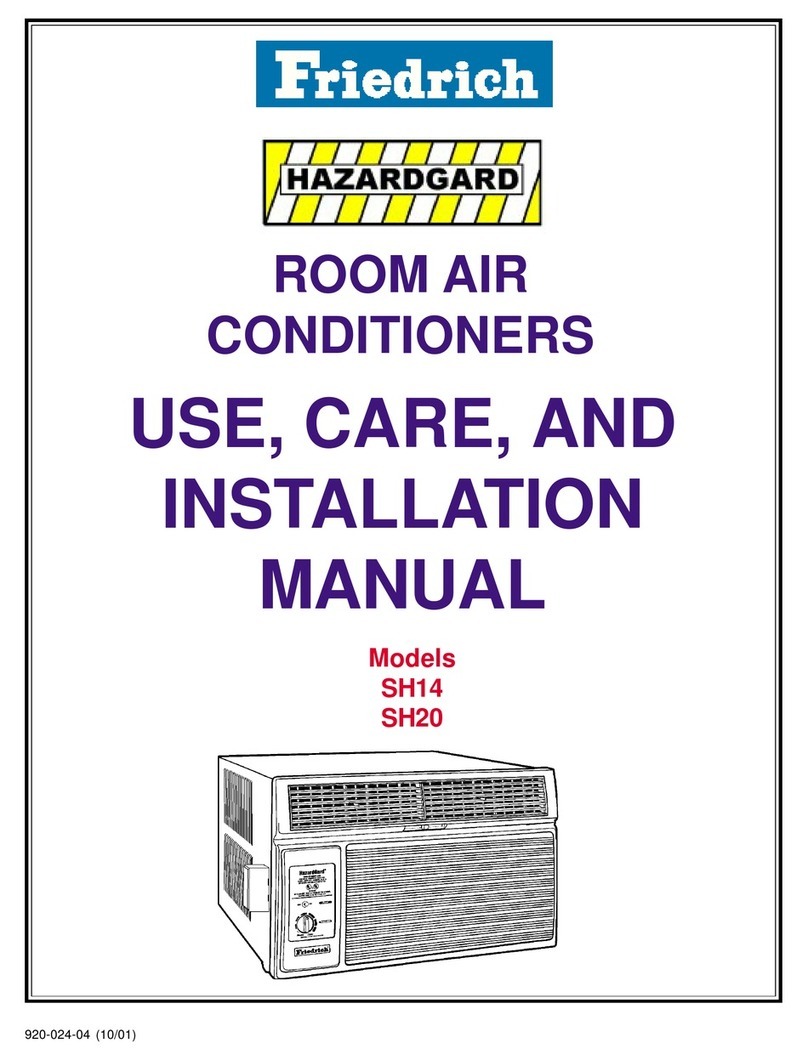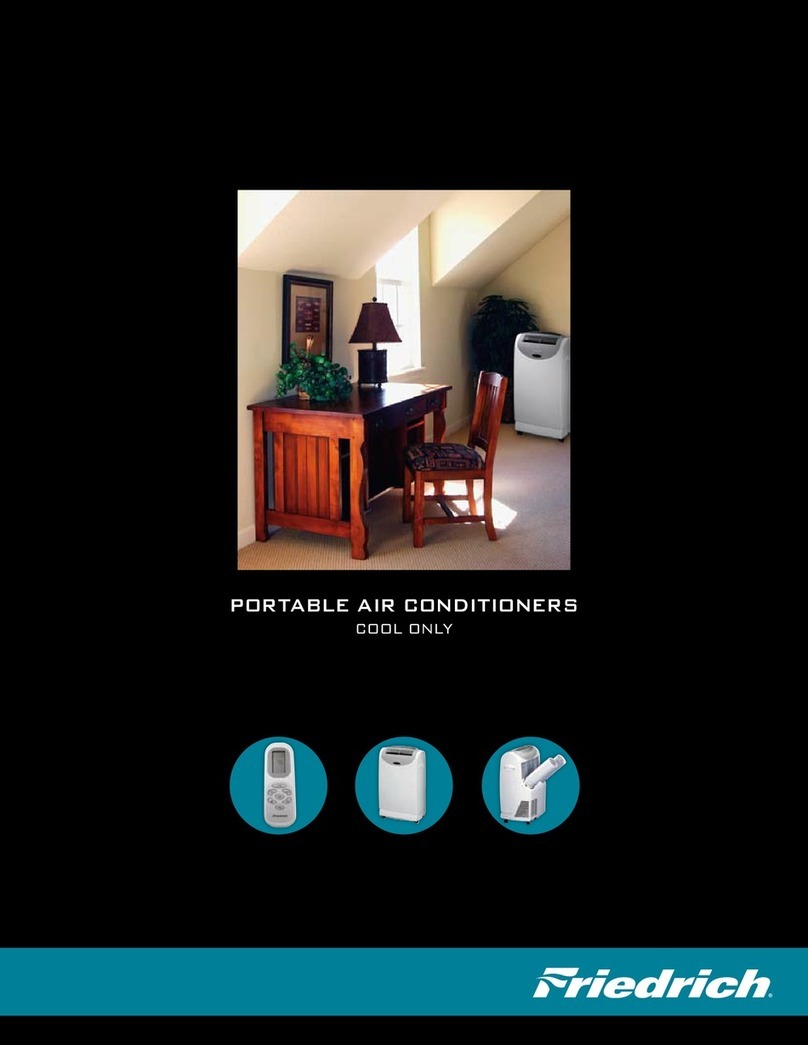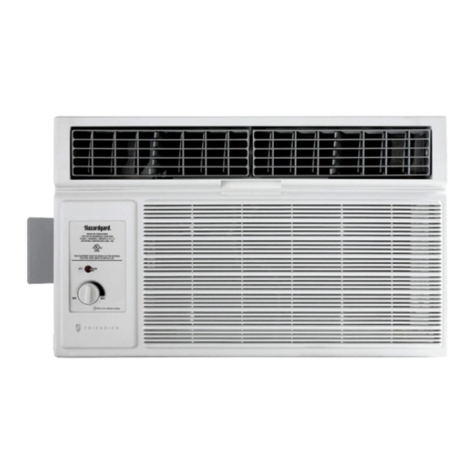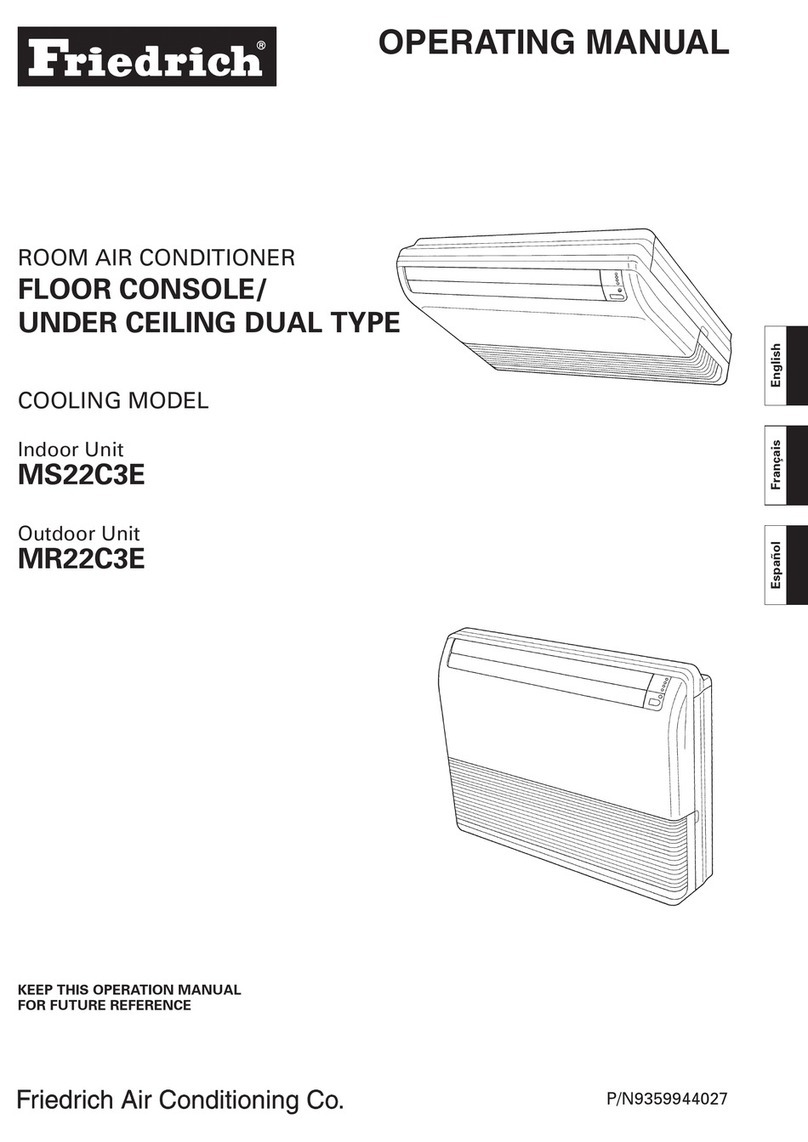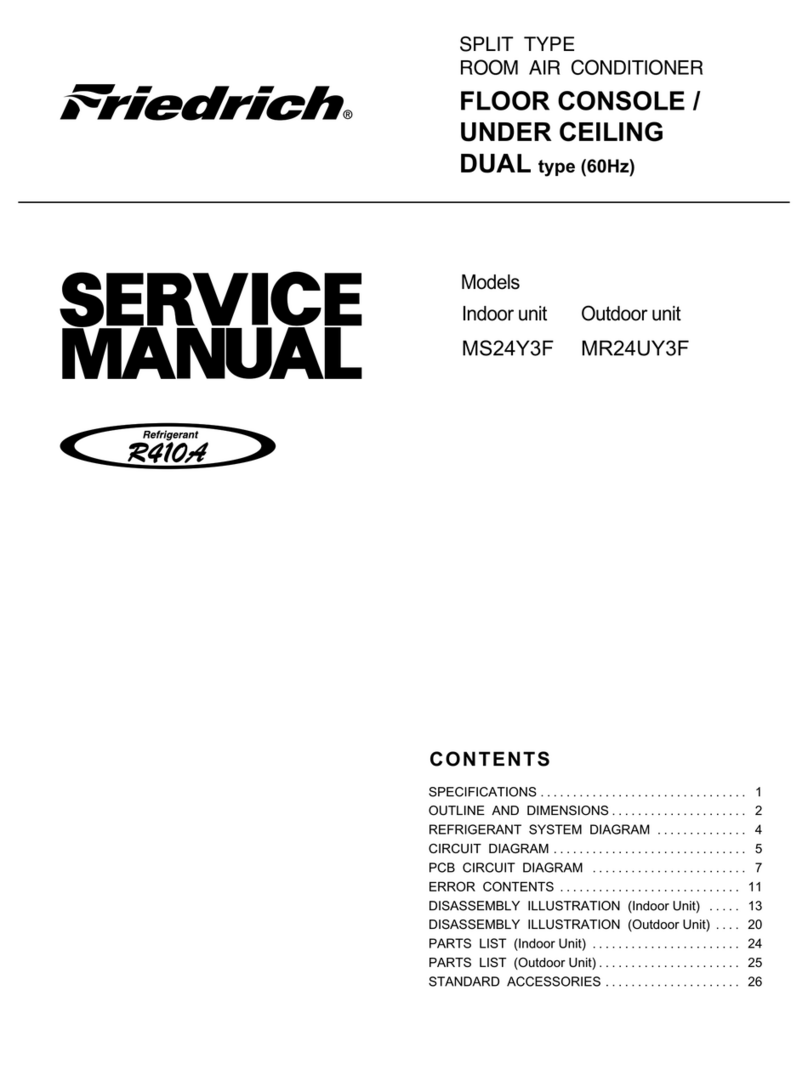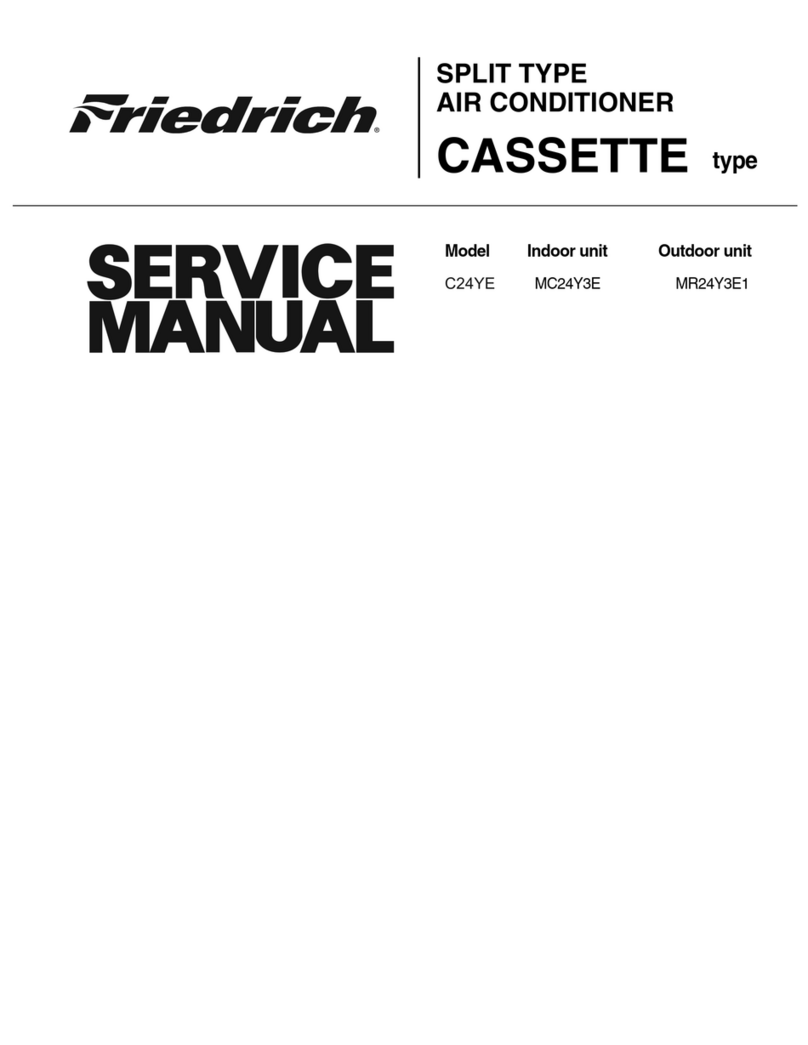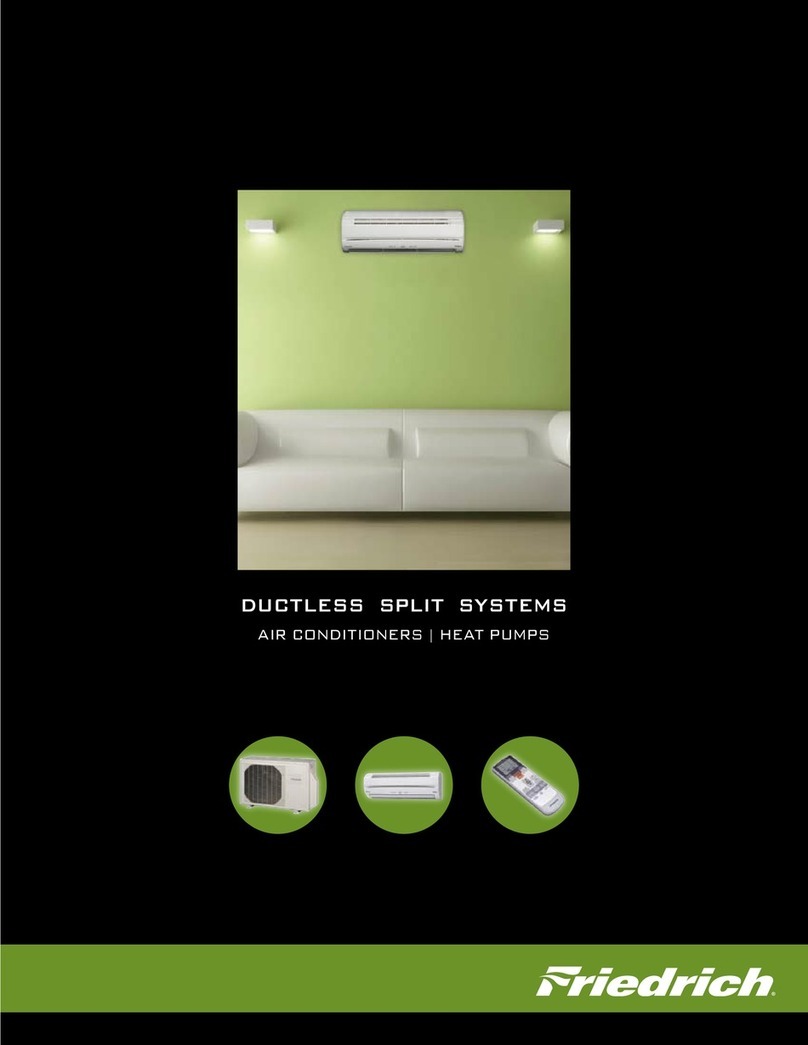Connection pipe assembly
Connection cord
Wall pipe
Decorative tape
Vinyl tape
Wall cap
Saddle
Drain hose
Tapping screws
Sealant
M10 bolt, nut
SPLIT TYPE ROOM AIR CONDITIONER
INSTALLATION MANUAL
(PART NO. 9315342973) ENGLISH
IMPORTANT!
Please Read Before Starting
This air conditioning system meets strict safety and operating stand-
ards. As the installer or service person, it is an important part of your
job to install or service the system so it operates safely and efficiently.
For safe installation and trouble-free operation, you must:
• Carefully read this instruction booklet before beginning.
• Follow each installation or repair step exactly as shown.
• Observe all local, state, and national electrical codes.
• Pay close attention to all danger, warning, and caution notices given
in this manual.
• Hazel alerting symbols
Electrical
Safety / alert
If Necessary, Get Help
These instructions are all you need for most installation sites and main-
tenance conditions. If you require help for a special problem, contact
our sales/service outlet or your certified dealer for additional instruc-
tions.
In Case of Improper Installation
The manufacturer shall in no way be responsible for improper installa-
tion or maintenance service, including failure to follow the instructions
in this document.
SPECIAL PRECAUTIONS
When Wiring
ELECTRICAL SHOCK CAN CAUSE SEVERE PERSONAL
INJURY OR DEATH. ONLYA QUALIFIED, EXPERIENCED
ELECTRICIAN SHOULDATTEMPTTO WIRE THIS SYSTEM.
• Do not supply power to the unit until all wiring and tubing are com-
pleted or reconnected and checked.
• Highly dangerous electrical voltages are used in this system. Care-
fully refer to the wiring diagram and these instructions when wiring.
Improper connections and inadequate grounding can cause acciden-
tal injury or death.
• Ground the unit following local electrical codes.
• Connect all wiring tightly. Loose wiring may cause overheating at
connection points and a possible fire hazard.
5 cm or over
The basic installation work procedures are the same as conventional refrigerant (R22) models.
However, pay careful attention to the following points:
(1) Since the working pressure is 1.6 times higher than that of conventional refrigerant(R22) mod-
els, some of the piping and installation and service tools are special.(See the table below.)
Especially, when replacing a conventional refrigerant(R22) model with a new refrigerant
R410A model, always replace the conventional piping and flare nuts with the R410A piping
and flare nuts.
(2) Models that use refrigerant R410A have a different charging port thread diameter to pre-
vent erroneous charging with conventional refrigerant(R22) and for safety. Therefore, check
beforehand.[The charging port thread diameter for R410A is 1/2 threads per inch.]
(3) Be more careful that foreign matter (oil, water, etc.) does not enter the piping than with
refrigerant(R22) models. Also, when storing the piping ,securely seal the opening by pinch-
ing, taping, etc.
(4) When charging the refrigerant, take into account the slight change in the composition of the
gas and liquid phases, and always charge from the liquid phase side whose composition is
stable.
This air conditioner uses new refrigerant HFC (R410A).
When Transporting
Be careful when picking up and moving the indoor and outdoor units.
Get a partner to help, and bend your knees when lifting to reduce
strain on your back. Sharp edges or thin aluminum fins on the air con-
ditioner can cut your fingers.
When Installing...
...In a Ceiling or Wall
Make sure the ceiling/wall is strong enough to hold the unit’s weight.
It may be necessary to construct a strong wood or metal frame to
provide added support.
...In a Room
Properly insulate any tubing run inside a room to prevent “sweating”
that can cause dripping and water damage to walls and floors.
...In Moist or Uneven Locations
Use a raised concrete pad or concrete blocks to provide a solid, level
foundation for the outdoor unit. This prevents water damage and ab-
normal vibration.
...In an Area with HighWinds
Securely anchor the outdoor unit down with bolts and a metal frame.
Provide a suitable air baffle.
...In a Snowy Area (for Heat Pump-type Systems)
Install the outdoor unit on a raised platform that is higher than drifting
snow. Provide snow vents.
When Connecting RefrigerantTubing
• Keep all tubing runs as short as possible.
• Use the flare method for connecting tubing.
• Apply refrigerant lubricant to the matching surfaces of the flare and
union tubes before connecting them, then tighten the nut with a
torque wrench for a leak-free connection.
• Check carefully for leaks before starting the test run.
NOTE:
Depending on the system type, liquid and gas lines may be either nar-
row or wide. Therefore, to avoid confusion the refrigerant tubing for
your particular model is specified as either “small” or “large” rather
than as “liquid” or “gas”.
When Servicing
• Turn the power OFF at the main circuit breaker panel before open-
ing the unit to check or repair electrical parts and wiring.
• Keep your fingers and clothing away from any moving parts.
• Clean up the site after you finish, remembering to check that no
metal scraps or bits of wiring have been left inside the unit being
serviced.
• After installation, explain correct operation to the customer, using
the operating manual.
(1) Do not use the existing (for R22) piping and flare nuts.
• If the existing materials are used, the pressure inside the refrigerant cycle will rise and cause breakage, injury,
etc. (Use the special R410A materials.)
(2) When installing and relocating the air conditioner, do not mix gases other than the specified refrigerant(R410A)
to enter the refrigerant cycle.
• If air or other gas enters the refrigerant cycle, the pressure inside the cycle will rise to an abnormally high
value and cause breakage, injury, etc.
WARNING
CAUTION
When installing pipes shorter than 17ft (5m), sound of the outdoor unit will be transferred to the indoor unit, which
will cause large operating sound or some abnormal sound.
Special tools for R410A
Contents of change
Pressure is high and cannot be measured with a conventional gauge.To prevent erroneous
mixing of other refrigerants, the diameter of each port has been changed.
It is recommended the gauge with seals-0.1 to 5.3 MPa (-1 to 53 bar) for high pressure.
-0.1 to 3.8 MPa (-1 to 38 bar) for low pressure.
To increase pressure resistance, the hose material and base size were changed.
A conventional vacuum pump can be used by installing a vacuum pump adapter.
Special gas leakage detector for HFC refrigerant R410A.
Tool name
Gauge manifold
Charge hose
Vacuum pump
Gas leakage detector
Copper pipes
It is necessary to use seamless copper pipes and it is desir-
able that the amount of residual oil is less than 40 mg/10m.
Do not use copper pipes having a collapsed, deformed or
discolored portion (especially on the interior surface). Oth-
erwise, the expansion value or capillary tube may become
blocked with contaminants.
As an air conditioner using R410A incurs pressure higher than
when using R22, it is necessary to choose adequate materials.
Thicknesses of copper pipes used with R410A are as shown in the table. Never use copper pipes thinner than that in
the table even when it is available on the market.
CONNECTION PIPE REQUIREMENT
Nominal
diameter
3/8in
5/8in
Outer
diameter
9.52mm
15.88mm
Thickness
0.8mm
1.0mm
Maximum height
(between indoor and
outdoor)
Maximum
length
INDOOR UNIT
CUTTINGTHE HOLE IN THE WALL FOR THE CONNECTING PIPING
(1) Cut a 3-1/8”(80 mm) diameter hole in the wall at the position shown
in the figure.
(2) When cutting the wall hole at the inside of the wall hook bracket, cut
the hole to a point of intersection of center marks.
When cutting the wall hole at the outside of the wall hook bracket, cut
the hole at a point of 10mm below.
(3) Cut the hole so that the outside end is lower (3/16” to 3/8” (5 to 10
mm)) than the inside end.
(4) Always align the center of the wall hole. If misaligned, water leakage
will occur.
(5) Cut the wall pipe to match the wall thickness, stick it into the wall cap,
fasten the cap with vinyl tape, and stick the pipe through the hole. (The
connection pipe is supplied in the installation set.)
(6) For left piping and right piping, cut the hole a little lower so that drain
water will flow freely.
INSTALLING THE WALL HOOK BRACKET
(1) Install the wall hook bracket so that it is correctly positioned horizon-
tally and vertically. If the wall hook bracket is tiled, water will drip to
the floor.
(2) Install the wall hook bracket so that it is strong enough to withstand
the weight of an adult.
●Fasten the wall hook bracket to the wall with 6 or more screws
through the holes near the outer edge of the bracket.
●Check that there is no rattle at the wall hook bracket.
WARNING
If the wall pipe is not used, the cord interconnecting
the indoor and outdoor units may touch metal and
cause electric leakage.
Wall hook bracket
Tapping screw
(size: large; quantity: 8)
Wall hook
bracket Weight
CAUTION
Install the wall hook bracket horizontally and perpen-
dicularly.
FORMING THE DRAIN HOSE AND PIPE
[Rear piping, Right piping, Bottom piping]
●Install the indoor unit piping in the direction of the wall hole and
bind the drain hose and pipe together with vinyl tape.
●Install the piping so that the drain hose is at the bottom.
●Wrap the pipes of the indoor unit that are visible from the outside
with decorative tape.
[For Left rear piping, Left piping]
Interchange the drain cap and the drain hose.
Drain cap
Indoor unit
drain hose
Remove the drain cap by pulling
at the projection at the end of
the cap with pliers, etc.
For left outlet piping, cut off the
piping outlet cutting groove with
a hacksaw.
Right piping
CAUTION
Insert the drain hose and drain cap into the drain port,
making sure that it comes in contact with the back of the
drain port, and then mount it. If the drain hose is not con-
nected properly, leaking will occur.
• Attach the Insulation (Drain hose) to the drain hose.
●For left piping and left rear piping, align the marks on the wall
hook bracket and shape the connection pipe.
●Bend the connection piping at the bend radius of 4”(100 mm) or
more and install no more than 1-3/8”(35 mm) from the wall.
●After passing the indoor piping and drain hose through the wall
hole, hang the indoor unit on the hooks at the top and bottom of
the wall hook bracket.
[Installing the indoor unit]
●Hang the indoor unit from the hooks at the top of the wall hook
bracket.
●Insert the spacer, etc. between the indoor unit and the wall hook
bracket and separate the bottom of the indoor unit from the wall.
After hooking the indoor unit to the top hook, hook the fittings of the indoor
unit to the two bottom hooks while lowering the unit and pushing it against
the wall.
Top hooks
Indoor unit
(Fitting) Bottom hooks
Indoor unit
Wall hook bracket
(Spacer)
CONNECTING THE PIPING
CONNECTION
(1) Install the outdoor unit wall cap (supplied with the optional
installation set or procured at the site) to the wall pipe.
(2) Connect the outdoor unit and indoor unit piping.
(3) After matching the center of the flare surface and tightening
the nut hand tight, tighten the nut to the specified tightening
torque with a torque wrench.
FLARING
(1) Cut th e connection pipe to the
necessary length with a pipe
cutter.
(2) H ol d the p ip e do wnw ard s o
that cuttings will not enter the
pipe and remove the burrs.
(3) I ns ert t he fl ar e nut o nt o the
pipe and flare the pipe with a
flaring tool.
Insert the flare nut (always use the
flare nut attached to the indoor
and outdoor units respectively)
onto the pipe and perform the flare
processing with a flare tool.
Use the special R410A flare tool,
or the conv-entional (for R22) flare
tool.
When using the conventional flare
tool, always use an allowance ad-
justment gauge and secure the A
dimension shown in the table.
BENDING PIPES
(1) When bending the pipe, be careful not to crush it.
(2) To prevent breaking of the pipe, avoid sharp bends.
Bend the pipe with a radius of curvature of 6” (150 mm) or
over.
(3)
If the copper pipe is bend the pipe or pulled to often, it will become
stiff.
Do not bend the pipes more than three times at one place.
Tighten with two wrenches.
Torque
wrench
Wrench (fixed)
Flare nut
Indoor unit pipe Connection pipe Toprevent gas leakage, coat the flare
surface with refrigerator oil.
CAUTION
(1) Fasten a flare nut with a torque wrench as instructed in this manual. If
fastened too tight, the flare nut may be broken after a long period of
time and cause a leakage of refrigerant.
(2) During installation, make sure that the refrigerant pipe is attached firmly
before you run the compressor. Do not operate the compressor under
the condition of refrigerant piping not attached properly with 3-way
valve open.This may cause abnormal pressure in the refrigeration cycle
that leads to breakage and even injury.
A (mm)
Pipe outside diameter
Pipe outside
diameter
ø 9.52 mm (3/8”)
ø 15.88 mm (5/8”)
Flare tool for
R410A, clutch type
0 to 0.5
0 to 0.5
Conventional (R22) flare tool
Clutch type
1.0 to 1.5
1.0 to 1.5
Wing nut type
1.5 to 2.0
1.5 to 2.0
Flare nut tightening torque and L dimension
Flare nut
3/8” (9.52 mm) dia.
5/8” (15.88 mm) dia.
Tightening torque
21.70 to 30.38 ft•lbs
(300 to 420 kgf•cm)
46.5 to 55.3 ft•lbs
(630 to 750 kgf•cm)
Check if [L] is flared uniformly
and is not cracked or scratched.
ELECTRICAL WIRING (INDOOR UNIT)
HOW TOTHE INSTALLTHE INTER-UNIT WIRE HARNESS
1. Remove the screws, then remove the conduit holder.
2. Fasten the inter-unit wire harness to the conduit holder using the lock nut.
IMPORTANT: Refer to figure of inlet-unit wire length about the length of
inter-unit wire harness.
3. Use the screws to install the conduit holder with which Inter-unit wire har-
ness is included.
4. Remove the screws, then remove the cord clamp.
5. Connect inter-unit wire harness to the terminal.
Refer to the wiring diagram.
6. Use the screws to install the cord clamp.
The method of adjusting inter-unit wire harness
To connect inter-unit wire harness to the terminal correctly, please
refer to the figure to adjust the length of the part of Inter-unitWire
harness ahead from conduit holder.
GENERAL
This INSTALLATION MANUAL briefly outlines where
and how to install the air conditioning system. Please
read over the entire set of instructions for the indoor
and outdoor units and make sure all accessory parts
listed are with the system before beginning.
1.
TYPE OF COPPER PIPE AND INSULATION MATERIAL
Copper tubing for connection the outdoor unit to the indoor
unit and insulation material is available for purchase locally.
When you purchase them, please specify the following.
A.
Deoxidized annealed copper pipe for refrigerant piping as:
STANDARD ACCESSORIES
The following installation accessories are supplied.
Use them as required.
ELECTRICAL REQUIREMENT
Always make the air conditioner power supply a special branch cir-
cuit and provide a special switch and receptacle. Do not extend the
power cord.
The following items are necessary to install this air conditioner. (The
items are not included with the air conditioner and must be purchased
separately.)
Cut each pipe to the appropriate length +12” (30 cm)
to16” (40 cm) to dampen vibration between units.
B.
Foamed polyethylene insulation for copper pipes as
required to precise length of piping. Wall thickness of the
insulation should not be less than 5/16” (8 mm).
C. Use insulated copper wire for field wiring.
CAUTION
Check local electrical codes and regulations
before obtaining wire.Also, check any specified
instructions or limitations.
ADDITIONAL CHARGE
Refrigerant suitable for a piping length of 66 ft (20 m) is charged in
the outdoor unit at the factory.
When the piping is longer than 66 f t (20 m), additional charging is necessary.
For the additional amount, see the table below.
Between 66 ft (20 m) and 165 ft (50 m), when using a connection
pipe other than that in the table, charge additional refrigerant with
0.43 oz/ ft (40g/1 m) as the criteria.
2.
ADDITIONAL MATERIALS REQUIRED FOR INSTALLATION
A. Refrigeration (armored) tape
B. Insulated staples or clamps for connecting wire
(See your local electrical codes.)
C. Putty
D. Refrigeration lubricant
E. Clamps or saddles to secure refrigerant piping
3. OPERATING RANGE
Name and Shape Q’ty Name and Shape Q’ty
Wall hook bracket Cloth tape
1 1
8
2
1
Name Q’ty
1
1
1
1
1
1
1 set
1
1 set
1
4 set
SELECTING THE MOUNTING
POSITION
INSTALLATION DIAGRAM OF
INDOOR AND OUTDOOR UNITS
Decide the mounting position with the customer as follows:
1. INDOOR UNIT
(1) Install the indoor unit level on a strong wall which is not subject
to vibration.
(2) The inle t and outle t ports should not be obstructed : the air
should be able to blow all over the room.
(3) Install the unit near an electric outlet or special branch circuit.
(4) Do not install the unit where it will be exposed to direct sunlight.
(5) Install the unit where connection to the outdoor unit is easy.
(6) Install the unit where the drain pipe can be easily installed.
(7) Take servicing, etc. into consideration and leave the spaces
shown in the figure. Also install the unit where the filter can be
removed.
2. OUTDOOR UNIT
(1) If possible, do not install the unit where it will be exposed to di-
rect sunlight. (If necessary, install a blind that does not interfere
with the air flow.)
(2)
Do not install the unit where a strong wind blows or where it is very dusty.
(3) Do not install the unit where people pass.
(4) Take your neighbors into consideration so that they are not dis-
turbed by air blowing into their windows or by noise.
(5)
Provide the space shown in the figure so that the air flow is not blocked.
Also for efficient operation, leave open three of the four direc-
tions front, rear, and both sides.
WARNING
Install at a place that can withstand the weight of
the indoor and outdoor units and install positively so
that the units will not topple or fall.
CAUTION
(1) Do not install where there is the danger of com-
bustible gas leakage.
(2) Do not install near heat sources.
(3) If children under 10 years old may approach the
unit, take preventive measures so that they can-
not reach the unit.
(4) Install the indoor unit on the wall where the
height from the floors more than 180 cm.
[INDOOR UNIT]
Remote
controller
[OUTDOOR UNIT]
4”(10 cm) or over
24”(60 cm) or over
4”(10 cm) or over
24”(60 cm) or over
10”
(25 cm)
or over
Tapping
screw(small)
Remote
controller
holder
2”(5 cm) or over
Wall hook bracket
2-1/2”(6 cm)
or over
2”(5 cm)
or over
60”(150 cm)
or over
(Wall cap)
70”(180 cm)
or over
• Do not directly install it on
the ground, otherwise it
will cause failure. 2”(5 cm) or over
•To obtain better operation effi-
ciency, when the outdoor unit
is installed, be sure to open
the front and left side.
Cord clamp
Screw Square hole
Insert the tab into the square hole of the indoor unit and
fasten with a screw.
Connection cord
